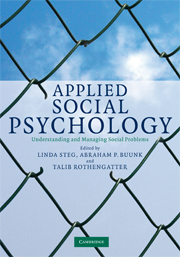Book contents
- Frontmatter
- Contents
- List of figures
- List of tables
- List of boxes
- List of contributors
- Acknowledgments
- 1 Introduction to applied social psychology
- 2 The USE of theory in applied social psychology
- 3 Applications of social psychology to increase the impact of behaviour-focused intervention
- 4 Research designs in applied social psychology
- 5 Social psychology and economic behaviour: heuristics and biases in decision making and judgement
- 6 Social psychology and immigration: relations between immigrants and host societies
- 7 Applying social psychology to the classroom
- 8 Social psychology and environmental problems
- 9 Gender issues in work and organizations
- 10 Social psychology of health and illness
- 11 Social psychology and mental health
- 12 Social psychology and modern organizations: balancing between innovativeness and comfort
- 13 Social psychology and the study of politics
- Index
- References
12 - Social psychology and modern organizations: balancing between innovativeness and comfort
- Frontmatter
- Contents
- List of figures
- List of tables
- List of boxes
- List of contributors
- Acknowledgments
- 1 Introduction to applied social psychology
- 2 The USE of theory in applied social psychology
- 3 Applications of social psychology to increase the impact of behaviour-focused intervention
- 4 Research designs in applied social psychology
- 5 Social psychology and economic behaviour: heuristics and biases in decision making and judgement
- 6 Social psychology and immigration: relations between immigrants and host societies
- 7 Applying social psychology to the classroom
- 8 Social psychology and environmental problems
- 9 Gender issues in work and organizations
- 10 Social psychology of health and illness
- 11 Social psychology and mental health
- 12 Social psychology and modern organizations: balancing between innovativeness and comfort
- 13 Social psychology and the study of politics
- Index
- References
Summary
Introduction
Imagine that you have just obtained your master's degree in social psychology and that you are hired by a large company such as Shell or British Telecom. What would you be able to offer your company from your recent studies in social psychology? In this chapter we will approach important themes of modern organizations from a social-psychological perspective. We will first briefly describe the societal context in which modern organizations operate and its implication for the workplace. More specifically, we will focus on two important developments. In the dynamic world we live in nowadays organizations continuously have to adjust their strategies to new environmental demands, for example, by bringing new products on the market in response to changing needs of customers. In addition, globalization and migration forces, as well as the increased number of women and older employees in the workplace, cause the workplace to be more and more diverse. Both developments turn the workplace into an environment that has a higher potential for group creativity and innovation, but that at the same time is less likely to be a source of safety and provide a sense of belonging.
In this chapter, we will use theoretical perspectives from social psychology to explain why change and diversity promote creativity and innovation. Perspectives on cognitive stimulation are particularly helpful in this regard. Moving on from social identity theory, we will show that both change and diversity may at the same time also endanger feelings of safety and belonging.
- Type
- Chapter
- Information
- Applied Social PsychologyUnderstanding and Managing Social Problems, pp. 271 - 290Publisher: Cambridge University PressPrint publication year: 2008
References
- 3
- Cited by



